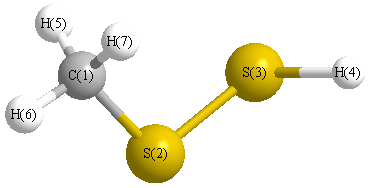Vibrational Frequencies calculated at B3LYP/6-31G*
| Mode Number |
Symmetry |
Frequency
(cm-1) |
Scaled Frequency
(cm-1) |
IR Intensities
(km mol-1) |
Raman Act
(Å4/u) |
Dep P |
Dep U |
|---|
| 1 |
A |
3169 |
3043 |
7.40 |
60.20 |
0.75 |
0.86 |
| 2 |
A |
3150 |
3025 |
6.76 |
89.95 |
0.75 |
0.86 |
| 3 |
A |
3064 |
2943 |
16.79 |
137.78 |
0.03 |
0.05 |
| 4 |
A |
2616 |
2513 |
28.05 |
168.87 |
0.32 |
0.49 |
| 5 |
A |
1508 |
1448 |
10.18 |
15.11 |
0.73 |
0.85 |
| 6 |
A |
1489 |
1429 |
8.70 |
21.56 |
0.75 |
0.86 |
| 7 |
A |
1382 |
1327 |
5.06 |
6.23 |
0.41 |
0.58 |
| 8 |
A |
995 |
956 |
10.41 |
6.40 |
0.59 |
0.74 |
| 9 |
A |
991 |
952 |
5.59 |
6.66 |
0.73 |
0.84 |
| 10 |
A |
893 |
857 |
10.00 |
32.88 |
0.64 |
0.78 |
| 11 |
A |
687 |
659 |
1.47 |
12.27 |
0.33 |
0.50 |
| 12 |
A |
490 |
470 |
0.79 |
16.87 |
0.28 |
0.43 |
| 13 |
A |
320 |
307 |
19.90 |
9.47 |
0.75 |
0.86 |
| 14 |
A |
236 |
226 |
0.27 |
5.57 |
0.58 |
0.74 |
| 15 |
A |
170 |
163 |
0.63 |
0.03 |
0.75 |
0.86 |
Unscaled Zero Point Vibrational Energy (zpe) 10579.4 cm
-1
Scaled (by 0.9603) Zero Point Vibrational Energy (zpe) 10159.4 cm
-1
See section
III.C.1 List or set vibrational scaling factors
to change the scale factors used here.
See section
III.C.2
Calculate a vibrational scaling factor for a given set of molecules
to determine the least squares best scaling factor.
Charges, Dipole, Quadrupole and Polarizability
Charges from optimized geometry at B3LYP/6-31G*
Charges (e)
| Number |
Element |
Mulliken |
CHELPG |
AIM |
ESP |
| 1 |
C |
-0.581 |
|
|
|
| 2 |
S |
0.028 |
|
|
|
| 3 |
S |
-0.132 |
|
|
|
| 4 |
H |
0.112 |
|
|
|
| 5 |
H |
0.198 |
|
|
|
| 6 |
H |
0.189 |
|
|
|
| 7 |
H |
0.187 |
|
|
|
Electric dipole moments
Electric dipole components in Debye
(What's a Debye? See section
VII.A.3)
| |
x |
y |
z |
Total |
| |
-1.112 |
1.367 |
0.988 |
2.020 |
| CHELPG |
|
|
|
|
| AIM |
|
|
|
|
| ESP |
|
|
|
|
Electric Quadrupole moment
Quadrupole components in D Å
| Primitive |
|---|
| | x | y | z |
|---|
| x |
-30.857 |
-0.404 |
1.969 |
| y |
-0.404 |
-35.041 |
0.668 |
| z |
1.969 |
0.668 |
-33.234 |
|
| Traceless |
|---|
| | x | y | z |
|---|
| x |
3.280 |
-0.404 |
1.969 |
| y |
-0.404 |
-2.995 |
0.668 |
| z |
1.969 |
0.668 |
-0.285 |
|
| Polar |
|---|
| 3z2-r2 | -0.570 |
|---|
| x2-y2 | 4.184 |
|---|
| xy | -0.404 |
|---|
| xz | 1.969 |
|---|
| yz | 0.668 |
|---|
|
Polarizabilities
Components of the polarizability tensor.
Units are
Å
3 (Angstrom cubed)
Change units.
| |
x |
y |
z |
| x |
8.890 |
0.505 |
0.209 |
| y |
0.505 |
5.550 |
0.117 |
| z |
0.209 |
0.117 |
4.899 |
<r2> (average value of r
2) Å
2
| <r2> |
104.501 |
| (<r2>)1/2 |
10.223 |
